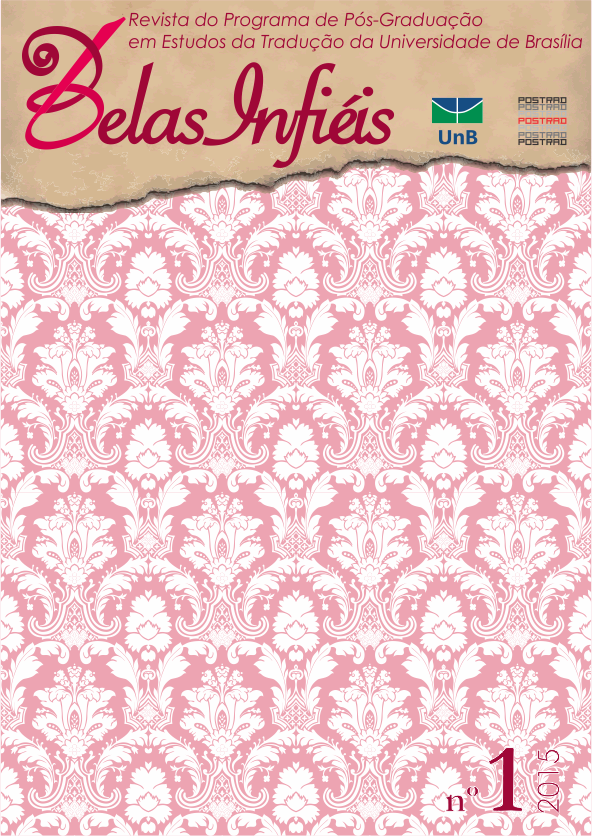TO EAT OR NOT TO EAT...IN VIGO:
THE TRANSLATOR SOLVES THE DILEMMA
DOI:
https://doi.org/10.26512/belasinfieis.v4.n1.2015.11313Palavras-chave:
Translation, Food, Culture, TourismResumo
What happens when a cruise tourist arrives in Vigo (Galicia-Spain) and feels culture-hungry enough to explore the local cuisine? There are two possible ways to go about it: walking around the port area and trying some of the exquisite dishes which are kindly offered by the surrounding caterers, or with modern day technology surfing the city’s websites, for example, http://www.turismodevigo.org. Precisely here, some of the information offered deals with typical food any visitor can taste and includes recipes and information about food festivals. “[A]s all our behaviour is culture-specific” (Vermeer, 1994, p. 10), this paper aims to discuss how the translation of food on this mainstream website translated from either Spanish or Galician (or both) into English and Portuguese, yet not into French or Italian, can encourage or discourage visitors from savouring some of the most typical Galician dishes. One of the challenges of Translation Studies is dealing with cross-cultural references, which always increase the difficulty of transferring content from one language to another. The specific cultural barriers related to food might lead the translator to modify, adapt or even omit some of the content in order to make the translation (and explicitly the food) more delectable.
Downloads
Referências
ANTONINI, Rachele; CHIARO, Delia. The Quality of Dubbed Television Programmes in Italy: the experimental design of an empirical study. In: ALBERTAZZI, Silvia; BONDI, Marina; BUONANNO, Giovanna; Nick MAXWELL, Claudia PELLICONI, Marc. SILVER (Eds.), Cross-cultural Encounters: New Languages, New Sciences, New Literatures. Roma: Officina, 2005.
DURÁN, Isabel. Analysing common mistakes in translation of tourist texts (Spanish, English and German).Onomázein, Chile, vol. 2, n. 26, p. 335-349. 2012.
KATAN, David. Il doppiaggio del cartone animato tra impossibilità e successo. In: DE ROSA, Gian Luigi (Eds.), Dubbing Cartoonia. Mediazione interculturale e funzione didattica nel processo di traduzione dei cartoni animati. Casoria: Loffredo Editore, 2010.
LARSON, Mildred. Meaning-Based Translation: A Guide to Cross-Language Equivalence. Lanham and New York: University Press of America, 1984.
NEWMARK, Peter. A textbook of translation. New York: Prentice Hall, 1988.
NORD, Christiane. Translation as a purposeful activity. Manchester: St Jerome, 1997.
SOTO, Jorge. La traducción de términos culturales en el contexto turístico español-inglés: recepción real en usuarios anglófonos. Quaderns, Revista de traducció, Barcelona, n. 20, p. 235-250. 2013.
VERMEER, Hans. Translation Today: Old and New Problems. In: SNELL-HORNBY, Mary et alii., Translation Studies ”“ An Interdiscipline. Vienna: John Benjamins, p. 3-16. 1994.
VLAKHOV, Sergei; FLORIN, Sider. Neperevodimoe v perevode. Realii. Masterstvo perevoda. Moskva: Sovetskij pisatel, n. 6, 1969, p. 432-456. 1970.
Downloads
Publicado
Como Citar
Edição
Seção
Licença
Dado ao acesso público desta revista, os textos são de uso gratuito, com obrigatoriedade de reconhecimento da autoria original e da publicação inicial nesta revista
A revista permitirá o uso dos trabalhos publicados para fins não comerciais, incluindo direito de enviar o trabalho para bases de dados de acesso público. As contribuições publicadas são de total e exclusiva responsabilidade dos autores.
Os autores, ao submeterem trabalhos para serem avaliados pela revista Belas Infiéis, mantêm os direitos autorais e concedem à revista o direito de primeira publicação, sendo o trabalho licenciado sob a Creative Commons Attribution License Atribuição 4.0 Internacional (CC BY 4.0).



















